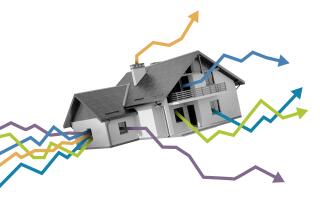Rising Rates Dampen Sales of Existing Homes : Real estate: The numbers edge up only slightly in October, led by gains in the West.
- Share via
WASHINGTON — Sales of previously owned homes barely moved in October, inching up just 0.5% for the first advance in three months as rising mortgage rates continued to brake housing activity.
Sales fell in all regions of the nation except for the West, and a real estate trade group warned that the higher costs of financing would continue to be a drag on the housing sector.
“There’s no question that resales will feel the brunt of the Fed’s generous rate increase. Adjustable-rate mortgages will be affected more than long-term rates, but increases in both can be expected,” said John A. Tuccillo of the National Assn. of Realtors. The Fed engineered a three-quarters of a percentage point rise in short-term rates on Nov. 15, the sixth increase in short-term rates this year.
The realtors said seasonally adjusted sales of existing single-family homes totaled an annualized 3.91 million in October, up from September’s revised 3.89 million rate. The initial September estimate was 3.97 million.
The revision meant that sales in September matched the 1% August decline, rather than rising 1%. Sales edged up 0.3% in July.
Despite the October advance, the rate was 3% below that of a year earlier, when it totaled 4.03 million and when housing activity was headed toward what analysts regard as the current cycle peak of 4.35 million in December, 1993.
The Federal Home Loan Mortgage Corp. said the average rate on 30-year fixed-rate mortgages was 8.93% in October, compared to 8.68% in September and 6.83% in October, 1993. The rate stood at 9.25% last week.
An increase from 7% to 9% would add $209 to the monthly payment on a $150,000 mortgage.
But despite rising rates, the realtors are predicting sales of 3.97 million existing homes this year, up from 3.80 million in 1993 and second only to 3.98 million in 1978.
“In the current interest rate environment, this is a vote of confidence in the economy,” said Edmund G. Woods Jr., Realtors Assn. president.
However, the median price for existing homes declined slightly in October as it often does when demand wanes. It was $107,900, down from $108,400 in September although it was up from $106,600 a year earlier.
The median is the midpoint, meaning half of the homes cost more and half cost less.
Regionally, the West posted the only increase in sales, a 3.7% gain to an 840,000 annual rate. The median price there was $139,900.
Elsewhere, sales were unchanged in the Northeast at a 560,000 rate and in the South at 1.43 million. The median price was $135,700 in the Northeast; $96,200 in the South.
Sales fell 1.8%, to a 1.07 million rate, in the Midwest, where the median price was $86,700.
Separately, the Federal Reserve Bank of Philadelphia said the economy is expected to grow more quickly this year than previously predicted, according to a survey of 30 forecasts.
The quarterly survey of 30 economic forecasters compiled by the Philadelphia Fed predicted the nation’s gross domestic product will grow 3.9% in 1994, up 0.2 percentage points from their forecast in the last survey. That compares with GDP growth of about 3% in 1993.
Existing Home Sales
Seasonally adjusted annual rate, in millions of units:
Oct, 1994: 3.91
* Source: National Assn. of Realtors
More to Read
Inside the business of entertainment
The Wide Shot brings you news, analysis and insights on everything from streaming wars to production — and what it all means for the future.
You may occasionally receive promotional content from the Los Angeles Times.










